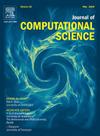Flow field analysis of Vortex Ring State through descent experiments and simulations with a quadcopter
IF 3.1
3区 计算机科学
Q2 COMPUTER SCIENCE, INTERDISCIPLINARY APPLICATIONS
引用次数: 0
Abstract
Vortex Ring State (VRS), which can occur during descent of rotorcraft including drones, is a flow field phenomenon that causes instability and may result in a crash. In the Lecture Note, Mori (2024) focused on the rotor model of a quadcopter to analyze the flow field during VRS [1]. In this study which is an extension of that research, descent experiments using a quadcopter drone was conducted to collect flight data on the descent speed and attitude angle at which VRS can occur. As a result, large roll angle change was observed at descent speeds close to hovering induced velocity. Next, descent simulation using the same quadcopter model as in the descent experiment was conducted using the velocity data obtained in the real experiments to verify the flow field in the VRS. The numerical fluid dynamics simulations were performed by combining Moving Computational Domain (MCD) method and sliding mesh method, and by considering the coupling between the fluid and the rigid body. As a result, vortex ring was observed around the rotors when the descent velocity was close to the hovering induced velocity. From the Q criterion isosurface, it is considered that the flow including the disturbance generated by the rotors is stagnant around the rotors, which leads to the instability of the quadcopter. Furthermore, the lift value fluctuation rate of more than 15 % indicates that VRS was likely to have occurred at descent speeds close to the hovering induced speed.
通过四轴飞行器下降实验和仿真分析了旋涡环状态的流场
涡环状态(Vortex Ring State, VRS)是旋翼飞行器(包括无人机)在下降过程中可能出现的一种流场现象,会导致飞行器失稳并可能导致坠毁。在讲座笔记中,Mori(2024)着重于四轴飞行器的转子模型来分析VRS[1]期间的流场。在这项研究中,作为该研究的延伸,使用四轴飞行器进行了下降实验,以收集可能发生VRS的下降速度和姿态角的飞行数据。结果,在接近悬停诱导速度的下降速度下,观察到较大的滚转角变化。接下来,使用与下降实验中相同的四轴飞行器模型进行下降仿真,利用实际实验中获得的速度数据对VRS中的流场进行验证。结合移动计算域(MCD)法和滑动网格法,考虑流体与刚体之间的耦合,进行了数值流体动力学模拟。结果表明,当下降速度接近诱导悬停速度时,旋翼周围存在旋涡环。从Q准则等值面上考虑,包含旋翼产生的扰动在内的流动在旋翼周围是停滞的,这将导致四轴飞行器的失稳。升力值波动率大于15% %,表明VRS很可能发生在接近悬停诱导速度的下降速度下。
本文章由计算机程序翻译,如有差异,请以英文原文为准。
求助全文
约1分钟内获得全文
求助全文
来源期刊

Journal of Computational Science
COMPUTER SCIENCE, INTERDISCIPLINARY APPLICATIONS-COMPUTER SCIENCE, THEORY & METHODS
CiteScore
5.50
自引率
3.00%
发文量
227
审稿时长
41 days
期刊介绍:
Computational Science is a rapidly growing multi- and interdisciplinary field that uses advanced computing and data analysis to understand and solve complex problems. It has reached a level of predictive capability that now firmly complements the traditional pillars of experimentation and theory.
The recent advances in experimental techniques such as detectors, on-line sensor networks and high-resolution imaging techniques, have opened up new windows into physical and biological processes at many levels of detail. The resulting data explosion allows for detailed data driven modeling and simulation.
This new discipline in science combines computational thinking, modern computational methods, devices and collateral technologies to address problems far beyond the scope of traditional numerical methods.
Computational science typically unifies three distinct elements:
• Modeling, Algorithms and Simulations (e.g. numerical and non-numerical, discrete and continuous);
• Software developed to solve science (e.g., biological, physical, and social), engineering, medicine, and humanities problems;
• Computer and information science that develops and optimizes the advanced system hardware, software, networking, and data management components (e.g. problem solving environments).
 求助内容:
求助内容: 应助结果提醒方式:
应助结果提醒方式:


